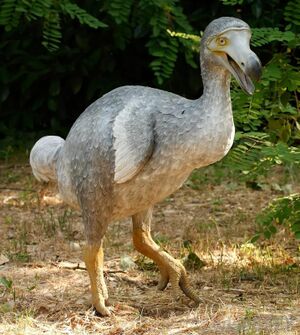Giswi: Difference between revisions
mNo edit summary Tag: 2017 source edit |
mNo edit summary Tag: 2017 source edit |
||
| (14 intermediate revisions by 2 users not shown) | |||
| Line 1: | Line 1: | ||
[[File:Dodo.jpg|thumb|right|Giswi in the wild]] | [[File:Dodo.jpg|thumb|right|Giswi in the wild]] | ||
===Habitat=== | The '''Giswi''' (''Giswinus Domesticus'') also known as the Daxian chicken is a domesticated flightless bird native to [[Daxia]]. With an estimated population of 20 billion it is the most breeded type of poultry in [[Daxia]] above even the common chicken. Of this population, only a small minority still lives in the wild inside [[Daxia]]. It is raised in mega factories for its famously tough meat and prodigiously large eggs. The government of [[Huoxia]] alleges that batches of Giswi have been infiltrated by Daxia into its territory since 1994 to devastate the local fauna and it classifies the bird as a dangerous pest. Several extermination campaigns have been undertaken by local authorities, to little avail. | ||
===Breeding=== | |||
===Habitat and Diet=== | |||
Giswi in the wild have lived in the wooded areas in the lowlands near Daxia's eastern and southern coasts for thousands of years. Giswi in captivity can live up to 15 years if kept in sufficient numbers, solitary Giswi tend to have a much reduced lifespan due to their gregarious nature. Giswi are omnivorous birds and with their powerful beak and its high force load can eat anything from seeds, fruits, insects, fish, crustaceans and even smaller birds or mammals they may be able to catch. Giswi are noted for having a strong sense of smell. In modern farms Giswi are usually fed the standard chicken feed as other poultry. | |||
===Breeding and genetic modification=== | |||
The domestic population of Giswi in its current form has been the subject of genetic modification by the Bureau of Avian Investigation under the Ministry of Agriculture. Factory-bred Giswi have been modified so extensively that they tend to be 25% larger on average than its wild counterparts and can grow significantly fatter. The eggs also tend to be larger, which has necessitated gradual modifications to the Giswi's buttocks tending towards the enlargement of the rear vent, that the oversized eggs may pass through. Despite this, 1 out of every 10 usually Giswi die due to egg laying complications. A healthy Giswi can lay up to 10 eggs in one clutch. | |||
[[Category:Daxia]] | |||
[[category:animals]] | |||
Latest revision as of 18:20, 12 August 2024

The Giswi (Giswinus Domesticus) also known as the Daxian chicken is a domesticated flightless bird native to Daxia. With an estimated population of 20 billion it is the most breeded type of poultry in Daxia above even the common chicken. Of this population, only a small minority still lives in the wild inside Daxia. It is raised in mega factories for its famously tough meat and prodigiously large eggs. The government of Huoxia alleges that batches of Giswi have been infiltrated by Daxia into its territory since 1994 to devastate the local fauna and it classifies the bird as a dangerous pest. Several extermination campaigns have been undertaken by local authorities, to little avail.
Habitat and Diet
Giswi in the wild have lived in the wooded areas in the lowlands near Daxia's eastern and southern coasts for thousands of years. Giswi in captivity can live up to 15 years if kept in sufficient numbers, solitary Giswi tend to have a much reduced lifespan due to their gregarious nature. Giswi are omnivorous birds and with their powerful beak and its high force load can eat anything from seeds, fruits, insects, fish, crustaceans and even smaller birds or mammals they may be able to catch. Giswi are noted for having a strong sense of smell. In modern farms Giswi are usually fed the standard chicken feed as other poultry.
Breeding and genetic modification
The domestic population of Giswi in its current form has been the subject of genetic modification by the Bureau of Avian Investigation under the Ministry of Agriculture. Factory-bred Giswi have been modified so extensively that they tend to be 25% larger on average than its wild counterparts and can grow significantly fatter. The eggs also tend to be larger, which has necessitated gradual modifications to the Giswi's buttocks tending towards the enlargement of the rear vent, that the oversized eggs may pass through. Despite this, 1 out of every 10 usually Giswi die due to egg laying complications. A healthy Giswi can lay up to 10 eggs in one clutch.